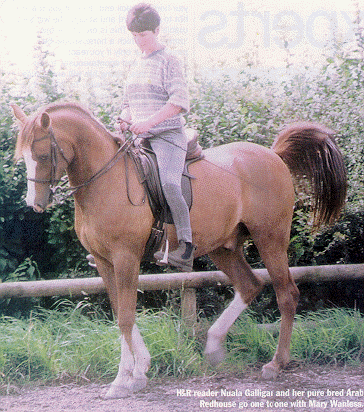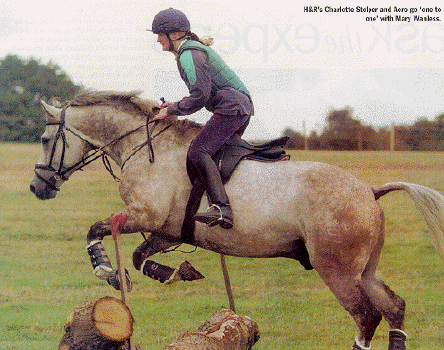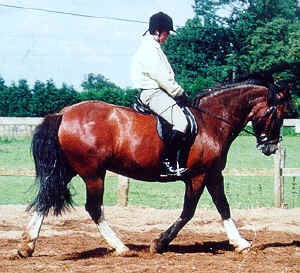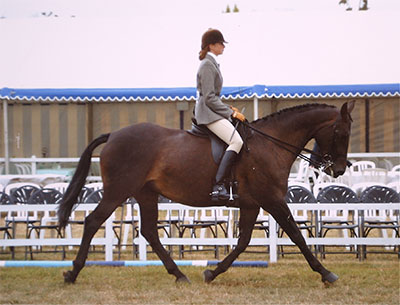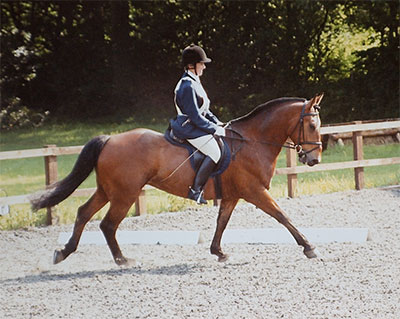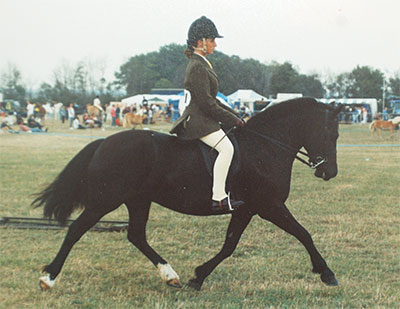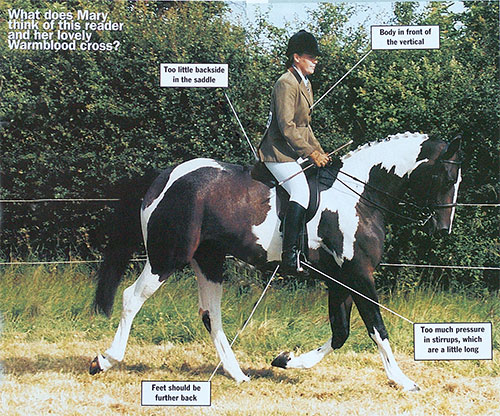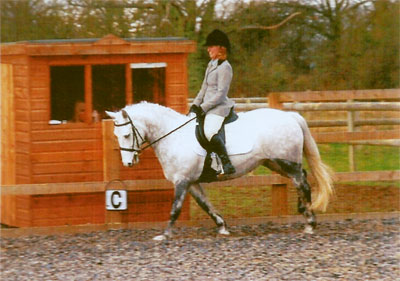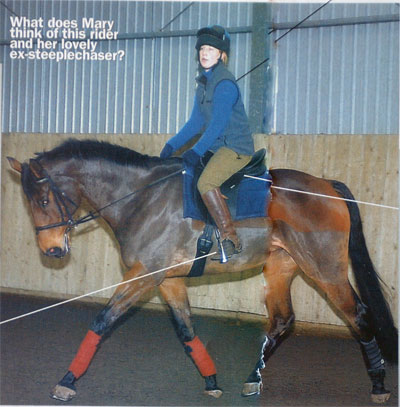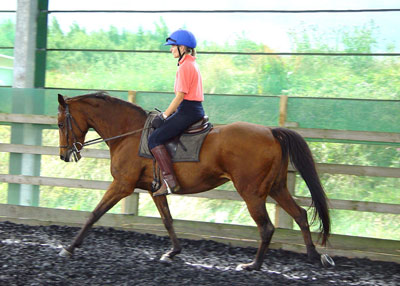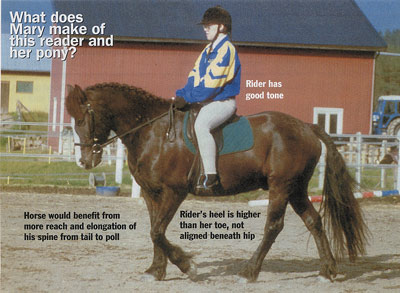RWYM
ARTICLE 24
 This photograph, taken on one of my courses, shows an American pupil riding my horse Luby, who is a 19 year old ¾ thoroughbred mare. I bought her as a crazy 9 year old, who had gone from pillar to post at the cheap end of the market, frightening people whilst becoming more and more hysterical. She is an extremely sensitive horse who is generous in the extreme, and who demands very precise riding. Although she has often worked on my courses as a school horse I am careful about who I put on her. I consider her my ‘laboratory horse’, for she has been my primary partner in working out much of what I know about rider biomechanics, and the rider/horse interaction. I love her to bits and intend to keep her fit, happy, and working well for as long as possible.
This photograph, taken on one of my courses, shows an American pupil riding my horse Luby, who is a 19 year old ¾ thoroughbred mare. I bought her as a crazy 9 year old, who had gone from pillar to post at the cheap end of the market, frightening people whilst becoming more and more hysterical. She is an extremely sensitive horse who is generous in the extreme, and who demands very precise riding. Although she has often worked on my courses as a school horse I am careful about who I put on her. I consider her my ‘laboratory horse’, for she has been my primary partner in working out much of what I know about rider biomechanics, and the rider/horse interaction. I love her to bits and intend to keep her fit, happy, and working well for as long as possible.
Lisa is pictured here at the top of the rise, and is showing us an exemplary balance. If we took the horse out from under her by magic she would land on the riding arena on her feet. Her heel is just below her toe, and she has not made the all-too-common mistake of pushing it down and forwards in a way that would make this balance point impossible. Her balance really does mirror that of a diver standing on a diving board about to do a backward dive – a useful diagnostic idea within rider biomechanics.
Her torso is very close to vertical, and she has made a particularly good job of opening the front angle between her thigh and her body. Few people make it to this point in the rise, and people who are used to doing a very small rise are usually horrified when I first ask them to make this big a movement. When they do not believe that the swing forward of the pelvis could possibly be this huge, I suggest that they watch videos of Kyra Kyrklund or Reine Klimke riding their young horses, and pause the tape at the top of the rise. Both riders show exemplary rider biomechanics in rising trot – as in the rest of their riding!
It is easy to look at this picture and imagine the whole movement, with Lisa’s knee as the centre point of a circle, the thigh as the radius of that circle, and the bony knobble at the top outside of the thigh (on the line where your pants begin) moving on an arc of that circle. Thus the thigh is rotated forward over the knee, whilst nothing from the knee down changes. In the ideal, barely any more weight is taken in the stirrup during the rise, although Lisa is shown here with too much weight in her foot.
The majority of riders push in their foot and straighten their knee as they rise, which makes their foot swing forward during the rise and back as they sit. Thus their lower leg is so tied into the movement that it does not lie still and ready to use whenever they need it. But the correct rise is not only neater, it is way more functional, yielding rider biomechanics that have a very positive influence on the horse’s carriage and movement. One of the keys to this is the way that most of the rider’s weight is taken in her thighs and not in her foot. In fact, many riders who are first learning good rider biomechanics find it helpful to imagine that their leg has been amputated from just below the knee. This stops them from relying on their stirrups, and makes them use their thigh muscles in the correct way.
To really understand this, kneel on the ground with a pad under your knees, and your backside resting on your heels. Put a hand on your front just below your sternum, and a hand on your back by your waistband. Your hands are there to make sure that your back does not move, and that your torso functions as a block. Now kneel up, bringing your backside over your knees to create the line you see here in Lisa.
I am sure you do not need me to tell you that this puts a significant strain on your thighs, as does rising trot done well. The two most common cop-outs are pushing in your foot instead of levering yourself up with your thighs, and rising by elongating the front of your body. To experience this, lift your chin and chest as you hollow your back and stick your backside out behind you. This raises your backside with no stress on your thighs – though you may well find that your back hurts. You have pulled yourself up from your chest and abdominal muscles, and are infact using the same mechanics as the horse who pulls himself along from his front legs. He too elongates under his stomach, through his chest, and along the underside of his neck, thus bringing himself ‘above the bit’. Very often the horse mirrors the rider’s biomechanics, and vica versa.
If you want to stimulate the correct movement pattern in your horse, you have to find it in yourself. This means that both of you have to push yourselves along from your hind legs. So return to that movement pattern, using the hands on your torso to make sure that you do not lengthen your front. Armed with this experience, check yourself out as you ride, monitoring the placing of your feet and the weight in the stirrup, and the length of your front. Help yourself find the correct balance point by staying out of the saddle at the top of the rise, firstly at a halt and then in walk and trot. Hold the mane to stop yourself from pulling your horse in the mouth if you topple backwards. In your quest for good rider biomechanics, start the easy way!
Really make sure that you rise by bringing your pelvis forward and not your shoulders. In rising trot the rider is inclined slightly forward in the sit (which makes it easier than the exercise described above), and on a powerful horse she rises to the point of having a straight vertical line from her knee up the front of the thigh and the front line of the torso. If you have shortened muscles on the front of the thigh and body, you will find it difficult to open the angle between them, and will be tempted to just advance your shoulders. Imagine someone pulling on the zip of your breeches, pulling you forward to this point, and making you open the angle between your torso and thigh.
The reasons why the rise needs to be this big are twofold. Firstly, the rider must reach this balance point in order to be in control of the movement, and secondly, her thrust must match the thrust of the horse’s hind leg – this is an important principle of good rider biomechanics, and to me, it seems intuitively obvious. Only then does she stay ‘with’ him. If she thrusts less than him, he is, in effect, towing her along, and on a whizzy horse this immediately creates a dynamic where the rider plays the role of a water skier whilst the horse pays the role of her motor boat. This rider is left counter-balancing on the reins, and the consequences of poor rider biomechanics are disasterous at worst, and limiting at best.
Notice how Lisa most definitely does not need her hands for support. The rein, in fact, is almost a loop, yet the horse is reaching into it very well. The underside of the neck is very relaxed, and the underside of the gullet is a very open inverted ‘U’ shape. In fact, when you look just at the angle of the underside of her jaw you imagine that she must be poking her nose; yet her nose is precisely on vertical, lying on the same line as the vertical edge of my whiteboard.
One rarely sees a horse so uncompromised by the rider’s hand, and with this degree of reach into the rein. (It is worth noting that the horse had a terrible ewe neck when I bought her, but correct work over time has created a wonderful line to her crest.) One might argue that the rein should make a more distinct contact, but I am happy with what I see here. The biggest potential criticism is that the horse may well not be tracking up – it is hard to know from a photograph taken at the phase in the stride, but I suspect that she will not be too far off.
Lisa is wearing one of my ‘Rider’s Belts’ around her pelvis (but is not using the overstrap, which gives you a way to pull on your own back). She found that the belt helped her to be aware of her pelvis, to breathe down into it, to feel solid and firm there, and to bear down. The belt was a huge help in developing these facets of good rider biomechanics, giving her constant feedback about whether or not she was pushing her stomach muscles against it. For in bearing down you push your guts against your skin, just as you do when you clear your throat. If, in contrast, you pull your stomach muscles in, your stomach and pelvis are going backwards, which creates a problem given that your horse is going forwards!
Rising trot is the best way to really learn to ‘go with’ the horse, and to match the forces which his movement exerts on your body. Good riderbiomechanics within rising trot mechanism are worth so much; they give you a baseline of rightness that you can come back to when everything else goes wrong, and it helps you set up the horse’s back before you go sitting and do more advanced work. It is well worth the time you invest in learning to do it well.


